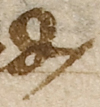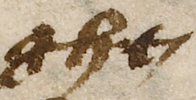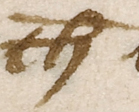|
| A |
 | Usage: planate(sic) single compartment 'a' is evenly formed and used throughout in lower case positions. |  | Usage: astrolabye
(second 'a') |
 | Usage: And
double compartment upper case letter to begin a new phrase. | | |
|
| D |
 | Usage: latytude
the scribe's looped 'd's are consistently formed. |  | Usage: dyrecte
an example from the rubric. The scribe's hand is controlled and even. |
 | Usage: forward
tagged 'd' in final postition. | | |
|
| G |
 | Usage: degrees
'g' is double compartment. The upper compartment is set slightly in advance of the lower compartment. |  | Usage: among
'g' in final position with a curl up at the end of the horizontal slash. It may be a flourish to signify a missing final 'e'. |
 | Usage: nyght | | |
|
| H |
 | Usage: that
the scribe can do an 'h' which is more or less upright. However, it is perhaps the speed with which the scribe copies that encourages an increasing slant to 'h' as he progresses. |  | Usage: whiche |
 | Usage: the
'h' at even more of a slant. |  | Usage: soth
'h' is not systematically crossed. This example is unusual on this folio. |
|
| R |
 | Usage: ryȝt
long 'r' used in all positions. |  | Usage: prikke
z'-shaped 'r' used after 'e', 'o' and some consonants. |
 | Usage: sterr(e)
both forms of 'r', with flourish attached to final long 'r' to replace 'e'? |  | Usage: retrograde |
|
| S |
 | Usage: almycant(er)as
kidney 's' used in final position. |  | Usage: co(n)clusyonys
occasionally sigma 's' is also used in final position. |
 | Usage: sette
long 's' used in initial and medial positions. The approach stroke is often visible as here. | | |
|
| W |
 | Usage: whiche
there is very little deviation in the form of this scribe's 'w' graph. |  | Usage: werkynge |
 | Usage: knowe
on the top line of the page in the rubric heading the scribe shows off his skills. | | |
|
| Y |
 | Usage: sothely
'y' is frequently, though not always, dotted. |  | Usage: latytude
the angle of the tail of 'y' has the same effect as the slanting descender from the shoulder stroke of 'h'. |
 | Usage: nyght
the fork of the two limbs of 'y' is here well beneath the lower level of surrounding letters. |  | Usage: mayst
here the two limbs of the letter make no connection. |
|
| Thorn and Yogh |
 | Usage: þat
a squat graph with short vertical. The short approach stroke usually used to begin the graph is not easily seen. |  | Usage: þe |
 | Usage: liȝth |  | Usage: ȝody-ak
yogh used to represent the 'z' sound for 'zodiak'. |
|
| p |
 | Usage: p(er)ceyue
'p' is distinctive with thick descender and a two-shaped element at the head in front of the stem. |  | Usage: planete
the lobe of 'p' is not closed at the head. |
 | Usage: excepcyon
a very clear example of the shape of the 'p' graph. The thick tapering curved stroke, sometimes with hook at the top and the small parallel curved stroke for the lobe are immediately recognisable. |  | Usage: p(ri)kke |





































